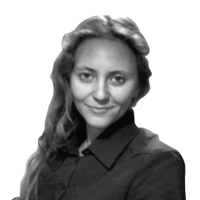SOCHI, Russia—When Vladimir Putin was first appointed “acting president” of Russia 17 years ago, nobody could have imagined that the image of Josef Stalin would appear on mugs and T-shirts on sale in Russian airports. There was a strong belief, then, that an independent Russia divested of the old Soviet republics had put its totalitarian history behind it, and condemned Stalin’s massive repression.
He had, after all, killed innocent people on a scale comparable only to the Nazis, shipping them off to the frozen gulags, starving them to death by the millions in Kazakhstan and Ukraine, and executing 700,000 more in The Great Terror of the late 1930s. In late August 1939, Stalin’s government signed a nonaggression pact with Hitler’s Germany that opened the way for the Nazis to invade Poland barely a week later. Yet Stalin’s image has been burnished under Putin in part because, after Hitler went ahead and invaded the Soviet Union, Stalin led the ferocious resistance that came to be known as The Great Patriotic War.
Today Stalin’s face can be seen on banners and souvenirs, apparently a source of national pride. Last weekend, for instance, a man glued Stalin’s portrait to the display in a food store here in the Russian city of Sochi, where President Putin has his summer residence. The banner with the portrait of the mustached dictator in a dress uniform quoted the late French President Charles De Gaulle: “Stalin didn’t walk away into the past, he dissolved into the future.” Similar banners appeared on the windows of Sochi’s bus fleets.
“This is madness, it is the same as if the Germans put Hitler’s portraits all over their cities,” Nadezhda Osipova, a student in Sochi, told The Daily Beast. “But I do not think that Putin wants a totalitarian Russia, for some unclear reason he wants a corrupt Russia, a police state,” the woman added.
All this came in anticipation of Russia Day, a national holiday meant to celebrate Russia’s independence from the collapsed Soviet Union in 1991—which is never an easy notion to grasp, especially at a time when Putin’s transparent ambition is to rebuild a new Russian empire on old models.
Fittingly, this year’s holiday, which fell on Monday, will be remembered as a clash of generations and ideologies. Hundreds of women and men, teenagers and old people were arrested for participating in anti-Kremlin rallies. Policemen beat protesters while dragging them away from the central streets and squares in at least 145 Russian cities.
The protest movement against corruption rocked Russia from east to west, turning upside down all the Kremlin’s plans for celebrations. Photographs of riot policemen detaining young women appeared on the homepages of internet media outlets Monday. In one picture, four uniformed police have grabbed a long-legged, blond activist, Maria Baronova. She is a leader of Open Russia, the exiled oligarch Mikhail Khodorkovsky’s public movement. Baronova was screaming, pushing to get free. Another veteran leader of the protest movement, Yulia Galiaming, was hospitalized with a concussion and a broken tooth, after a policeman hit her in the face.
Police detained 21-year-old activist Olga Tochenaya in Makhachkala, a city in Dagestan. In a photograph from Dagestan’s anti-corruption protest, Tochenaya holds out a sign from the window of a police bus, which says: “For our freedom and yours,” a traditional slogan of Russian dissidents.
By Monday evening, police reported more than 1,000 detainees in Moscow and St. Petersburg. Dozens were put behind bars in other Russian towns.
Clearly that was not how the Kremlin imagined the Day of Russia celebrations.
For months, Moscow authorities were preparing what they called a “Times and Epochs” festival, meant to look further back in Russian history than 1991.
Moscow’s main avenue, Tverskaya, was divided into 17 thematic zones, introducing theatrical tales of Russia’s history, military uniforms, and weapons used on the land of Russia in the ninth and 13th centuries, as well as during Napoleon’s invasion of Russia in 1812. On display was ammunition used by Peter the Great’s army in the 18th century and the Soviet army in 1930s, the years of Josef Stalin’s cult of personality. Soviet songs and movies played in Moscow parks, military instructors gave brief courses on how to provide first aid and showed off artillery pieces.
Opposition leader Aleksey Navalny called for protesters to gather on Tverskaya, too, for a rally that was not sanctioned by authorities. Hundreds of opposition activists, lots of them teenagers, poured onto the festive street chanting: “Putin is a thief! Putin is a thief!”
But Navalny was not with the protesters. Police detained him at his apartment in the morning, before he could join the rally, and he was quickly sentenced to 30 days in jail.
Some protesters had Russian national flags in their hands. In the videos published on YouTube, policemen twisted activists’ arms, and clubbed others on the ground. ON their morning show, radio Echo of Moscow asked a Moscow city hall official what could provoke a detention.
“The official told us that police are to detain anybody carrying a banner or yelling opposition slogans,” Olga Bychkova, deputy chief editor of Echo of Moscow told The Daily Beast. “And also, they intended to detain suspicious people who did not express joy together with everybody else at the festival but expressed ‘some other feelings.’”
Which makes us think again of that observation by De Gaulle. What does it mean, Stalin “dissolved into the future”? We are finding out all the time.





